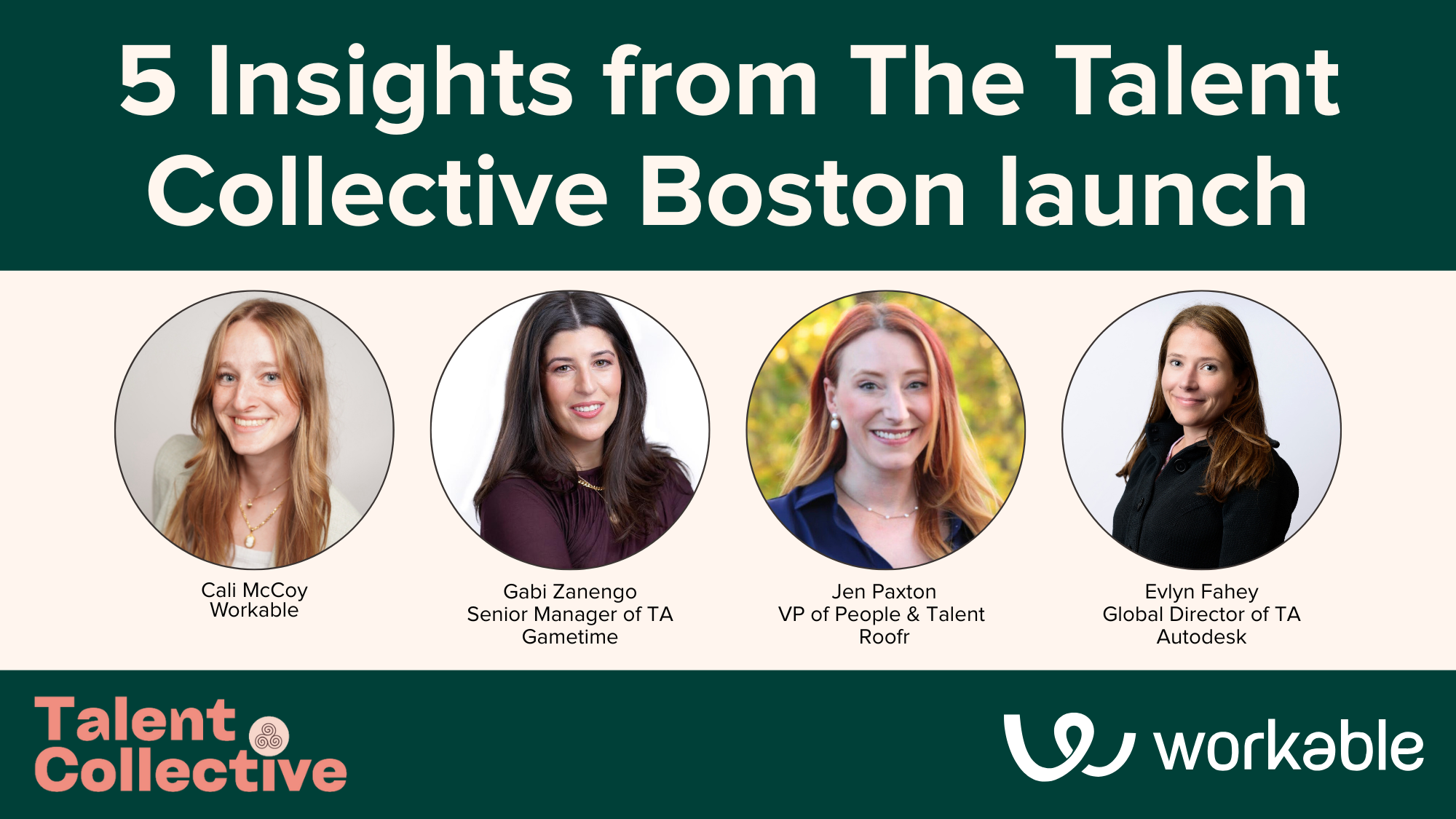How to fix your candidate experience strategy
Panicking over negative Glassdoor reviews? Wondering why you lose candidates after the assessment phase? Experimenting with a ‘shiny app’ to expand your candidate outreach? If you’re a recruiter or a hiring manager, this is probably a typical day at work. And you know exactly how important it is to keep your candidates happy and how hard you toil to build your candidate experience strategy.

This is why, on Jan. 23, 2020, at Workable we co-hosted a webinar with our partner HackerRank, titled What’s Wrong with your Candidate Experience (and How to Fix it), to shed some light on common pain points in candidate experience troubles.
Speakers in attendance were:
- Amy Miller, Senior Technical Recruiter at Amazon
- Sean Echevarria, Senior Product Manager at Walmart
- Blane Shields, Director of Customer Success at HackerRank
We’ve pulled together their most powerful points and practices they use to improve their candidate experience strategy. They are as follows:
Setting clear expectations from scratch
If you want to create an exceptional candidate experience, you must fulfill your candidate’s expectations. And this starts with ensuring the role and responsibilities are as clear as can be. Amy highlights how essential it is to partner with hiring teams in order to understand the skills expected of prospective candidates, what they can bring to the team, and ultimately what you’re trying to achieve by filling that position.
“We need to focus on and agree on what is the business problem that we’re trying to solve, and the talent we need to solve that problem.”
All these skills and qualifications should be outlined in the job ad itself. Sean explained the importance of crafting unique and clear job descriptions:
“You don’t want everything to be so standardized that a role doesn’t really make sense. There are unique aspects to each role, and so you want to make sure that those get defined ahead of time.”
Speaking of job ads, the speakers believe that including salaries in job descriptions can be tricky. When recruiters specify a range, says Amy, candidates usually look at the top end of the scale and might be disappointed with the real number when offered the position. However, employers don’t usually lose candidates because of salary miscommunications, as Amy highlighted:
“Usually, [candidates have] got three or four competing offers, so somebody’s got to lose. It’s going to be more based on job content, role satisfaction, team fit. It’s rarely about the money.”
Integrating tech into hiring
New technology, artificial intelligence, ATS platforms. They are in almost every recruiter’s toolkit and they are continually developing and evolving. But what do you need to know when you first incorporate tech into your recruitment efforts? According to Sean, it’s important to know every interaction the candidate goes through to help with troubleshooting when needed.
“It’s all about; how seamless can I make it? Is it a link once they go on there? Are you vetting how easy it is to use? Can you get internal employees to help vet certain technologies?”
Amy continues in the same mindset, while shifting attention to using tech specifically for assessments. For Amy, tech must be easy to use and relevant for the candidate.
“[And then] moving into the assessment piece, is it relevant? Are you going to learn something about me and my background that’s important, and that basically proves my fit for the job? Is it a personality assessment? I don’t like that. But is it a technically relevant exercise or test? Great.”
Is there a danger of recruiting becoming less personalized due to technology, and impacting candidate experience? Amy believes that the onus is on recruiters and managers to avoid that. Sean adds the importance of bringing specialized recruiters onboard, who know how to use the new technology while still maintaining that personal connection.
“As technology continues to expand, you’re now bringing in people who are coming in purely for machine learning, or purely for artificial intelligence, and you need to be able to talk their language, and make it personalized, otherwise you’re going to lose out on them.”
Evaluating data wisely
Email open rates, time to hire and participation rates are some of the candidate experience metrics recruiters track. But how do you analyze data effectively? Amy starts with the importance of benchmarking at every step of the process, from phone screen to on-site interviews. She also highlights the difference between data points and trends when figuring out what your data really means.
“I’m looking for trends, I’m looking for things that are coming up repeatedly over and over again with multiple people, not just one angry person.”
Now, if a recruiter identifies a small gap or bottleneck in their candidate experience strategy, for example low acceptance rates, how can they react? Sean emphasizes on the significance of doing things mindfully, without rushing:
“Focus on key areas that you know are an issue, versus trying to tackle the whole candidate experience. If it’s specifically for the onsite experience, then focus on the onsite experience, and don’t do anything else for a quarter.”
Catching up with hiring trends
Not all recruitment processes evolve equally. According to Blane, adapting to new trends is not a piece of cake for all companies. Small companies find it easier to adopt new agile processes while large companies might find it hard.
“Tech forward companies have been trying a lot of different strategies in terms of candidate engagement, whether that’s doing something really cool with a career fair, or they’re plugging in assessments, or they’re doing some sort of a panel interview onsite. They’re trying different things to see what sticks and what really resonates with candidates, because candidate experience is probably the most important thing that we hear from recruiters.”
However, according to Amy, there is no need to jump to the next “shiny thing”, like apps and platforms (e.g. recruiting via TikTok) all the time, as it can, in her own words, be “annoying to the audience”.
“There’s not a ‘one size fits all’. [For] your audience, especially if you are a larger [company] and you are hiring all kinds of people, there is not a single way to recruit, there is not a single platform, a single type of assessment, a single interview structure.”
Blane and Sean agree on the value good content brings to candidate experience. “I think content is super important”, Blane says, adding that customization of the content matters, especially for companies ‘that don’t have as big of a brand’.
Sean agreed, noting that it is meaningful to have a “toolkit” with the latest articles, videos and campaigns recruiters can use in order to better engage candidates.
Dealing with negative reviews
The importance of playing the long game also applies when reacting to negative reviews – in that you don’t want to react to every single one. Amy said:
“You could have one very frustrated job seeker, or a previous candidate who’s very angry, had a very bad experience and that may just be a single data point. That may not necessarily mean that your program is broken or that everything’s wrong. We don’t normally hear from people unless they’re upset.”
To thoroughly understand recruiting processes, a recruiter needs to have as much feedback from candidates as possible. Blane explained:
“We actually ask for candidate feedback immediately after they’ve taken that assessment. There’s no better point in time than to get that feedback right away.”
But what happens with negative Glassdoor reviews, or an excessive rant from candidates or former employees on Twitter and other social media? Amy said:
“I think the world has become smaller in many ways, just because of our connections with LinkedIn, and Twitter, and Facebook, and all the social media, and if you have a bad experience you’re very, very quick to go and post that somewhere that can easily go viral.”
In order to deal with this issue, Sean suggested to be open-minded and make yourself available to candidates for feedback.
“Having that feedback loop open, is needed when you have so many people coming through your front door. Create a conversation with them, and say OK, these were the parts of your experience that were bad. Whether or not you want to take culpability for it that’s fine, but we hear you and we’re going to continue to iterate off of our candidate experience.”
To sum up, improving your candidate experience techniques requires many small steps and it’s better to do them one at a time but without expecting a complete resolution each time. It’s an ongoing process. Make good use of your data, be smart with your tech implementation and keep tabs on trends. Also, be clear in your communications with the candidate, and don’t get disappointed with every single bad review you receive. All feedback is beneficial and you can learn from it.
See how Workable helps IMAGR deliver the best candidate experience and retain great talent:
Read also these candidate experience survey questions and gather useful feedback from candidates.




